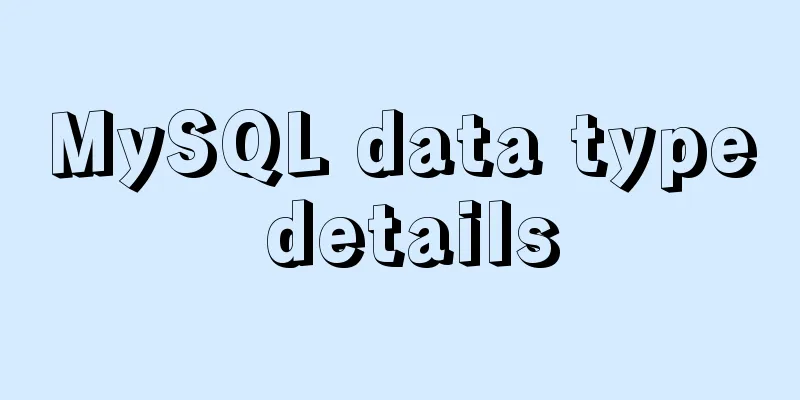MySQL data type details

1. Numeric Type1.1 Classification of numerical types
Numeric types in MySQL:
1.1.1 Floating point numbers If the precision and scale are not written for floating-point numbers, they will be displayed according to the actual precision value. If the precision and scale are written, the rounded result will be automatically inserted and the system will not report an error. If the precision and scale are not written for fixed-point numbers, the operation will be performed according to the default value 1.1.2 Bit TypeBIT (bit) type: ranges from 1-64. If not set, the default is 1 bit. For this field, you will not see the result if you use the select command directly. You can use the bin() (display in binary format) or hex() (display in hexadecimal format) function to read it. example: mysql> desc t2; +-------+--------+------+-----+---------+-------+ | Field | Type | Null | Key | Default | Extra | +-------+--------+------+-----+---------+-------+ | id | bit(1) | YES | | NULL | | +-------+--------+------+-----+---------+-------+ 1 row in set (0.00 sec) mysql> insert into t2 values(1); Query OK, 1 row affected (0.05 sec) mysql> select * from t2; +------+ |id| +------+ | | +------+ 1 row in set (0.00 sec) mysql> select bin(id),hex(id) from t2; +---------+---------+ | bin(id) | hex(id) | +---------+---------+ | 1 | 1 | +---------+---------+ 1 row in set (0.03 sec) When inserting For example, if you insert 2 into the table just now, the actual binary value is 10, which exceeds the actual defined number of mysql> insert into t2 values(2); ERROR 1406 (22001): Data too long for column 'id' at row 1 mysql> alter table t2 modify id bit(2); Query OK, 1 row affected (0.67 sec) Records: 1 Duplicates: 0 Warnings: 0 mysql> insert into t2 values(2); Query OK, 1 row affected (0.03 sec) mysql> select bin(id),hex(id) from t2; +---------+---------+ | bin(id) | hex(id) | +---------+---------+ | 1 | 1 | | 10 | 2 | +---------+---------+ 2 rows in set (0.00 sec) 1.1.3 Time and date type1.1.3 Time and date type
Example 1: Create a timetable (dt) with three date types in the fields: date, time, and datetime, and insert values to view the displayed results mysql> create table dt(d date,t time,dt datetime); Query OK, 0 rows affected (0.23 sec) mysql> insert into dt values(now(),now(),now()); Query OK, 1 row affected, 1 warning (0.05 sec) mysql> select * from dt; +------------+----------+---------------------+ | d | t | dt | +------------+----------+---------------------+ | 2021-05-13 | 10:14:07 | 2021-05-13 10:14:07 | +------------+----------+---------------------+ 1 row in set (0.00 sec) Example 2: Create a test table t, set the field id1 to TIMESTAMP type, insert a null value, and display mysql> create table t(id1 timestamp); Query OK, 0 rows affected (0.22 sec) mysql> insert into t values(null); Query OK, 1 row affected (0.05 sec) mysql> select * from t; +---------------------+ | id1 | +---------------------+ | 2021-05-13 10:18:05 | +---------------------+ 1 row in set (0.00 sec) It can be found that the system automatically creates a default value of Example 3: Explanation as above
mysql> alter table t add column id2 timestamp;
Query OK, 0 rows affected (0.48 sec)
Records: 0 Duplicates: 0 Warnings: 0
mysql> show create table t \G;
*************************** 1. row ***************************
Table: t
Create Table: CREATE TABLE `t` (
`id1` timestamp NOT NULL DEFAULT CURRENT_TIMESTAMP ON UPDATE CURRENT_TIMESTAMP,
`id2` timestamp NOT NULL DEFAULT '0000-00-00 00:00:00'
) ENGINE=InnoDB DEFAULT CHARSET=latin1
1 row in set (0.00 sec)
ERROR:
No query specified
1.1.4 String Type
example:
mysql> create table varc(v varchar(4),c char(4));
Query OK, 0 rows affected (0.20 sec)
mysql> insert into varc values('abc ','abc ');
Query OK, 1 row affected (0.03 sec)
mysql> select length(v),length(c) from varc;
+-----------+-----------+
| length(v) | length(c) |
+-----------+-----------+
| 4 | 3 |
+-----------+-----------+
1 row in set (0.01 sec)
mysql> select concat(v,'+'),concat(c,'+') from varc;
+---------------+---------------+
| concat(v,'+') | concat(c,'+') |
+---------------+---------------+
| abc + | abc+ |
+---------------+---------------+
1 row in set (0.00 sec)
example: mysql> create table bina(c binary(3)); Query OK, 0 rows affected (0.22 sec) mysql> insert into t set c='a'; ERROR 1054 (42S22): Unknown column 'c' in 'field list' mysql> insert into bina set c='a'; Query OK, 1 row affected (0.05 sec) mysql> select *,hex(c),c='a',c='a\0',c='a\0\0' from bina; +------+--------+-------+---------+-----------+ | c | hex(c) | c='a' | c='a\0' | c='a\0\0' | +------+--------+-------+---------+-----------+ | a | 610000 | 0 | 0 | 1 | +------+--------+-------+---------+-----------+ 1 row in set (0.00 sec) It can be found that when saving a 1.1.5 ENUM Type example:
mysql> create table gend(gender enum('M','F'));
Query OK, 0 rows affected (0.20 sec)
mysql> insert into gend values('M'),('F'),('1'),(null);
Query OK, 4 rows affected (0.03 sec)
Records: 4 Duplicates: 0 Warnings: 0
mysql> select * from gend;
+--------+
|gender|
+--------+
| M |
| F |
| M |
| NULL |
+--------+
4 rows in set (0.00 sec)
From this we can see that when inserting values of enumeration type, the case is ignored and the initial subscript starts from 1; when querying, it will be converted to uppercase, and null can also be inserted. 1.1.6 SET type A set of 1 to 8 members, occupying 1 byte. example:
mysql> create table st(col set('a','b','c','d'));
Query OK, 0 rows affected (0.20 sec)
mysql> insert into st values('a,b'),('a,d,a'),('a,c'),('a');
Query OK, 4 rows affected (0.03 sec)
Records: 4 Duplicates: 0 Warnings: 0
mysql> insert into st values('f');
ERROR 1265 (01000): Data truncated for column 'col' at row 1
mysql> insert into st values(null);
Query OK, 1 row affected (0.03 sec)
mysql> select * from st;
+------+
| col |
+------+
| a,b |
| a,d |
| a,c |
| a |
| NULL |
+------+
5 rows in set (0.00 sec)
From this we can see that set can insert multiple members, and can also insert null. When inserting a non-existent definition column, an exception will be reported and the insertion will fail. You may also be interested in:
| |||||||||||||||||||||||||||||||||||||||||||||||||||||||||||||||||||||||||||||||||||||||||||||||||||||||||||||||||||
<<: Some useful meta setting methods (must read)
>>: 33 ice and snow fonts recommended for download (personal and commercial)
Recommend
Summary of commonly used SQL in MySQL operation tables
1. View the types of fields in the table describe...
Detailed tutorial on installing php-fpm service/extension/configuration in docker
When I installed php56 with brew on mac , I encou...
Detailed explanation of the relationship between Vue and VueComponent
The following case reviews the knowledge points o...
Example of Vue uploading files using formData format type
In Vue, we generally have front-end and back-end ...
MySQL Full-text Indexing Guide
Full-text indexing requires special query syntax....
JavaScript canvas realizes dynamic point and line effect
This article shares the specific code for JavaScr...
HTML framework_Powernode Java Academy
1. Framework A browser document window can only d...
SVG+CSS3 to achieve a dynamic wave effect
A vector wave <svg viewBox="0 0 560 20&qu...
How to deploy springcloud project with Docker
Table of contents Docker image download Start mys...
What is the difference between HTM and HTML? What is the difference between HTM and HTML?
In the process of learning web design, I did not ...
Understanding and using callback functions in JavaScript
Table of contents Overview What are callbacks or ...
Implementing password box verification information based on JavaScript
This article example shares the specific code of ...
How to write HTML head in mobile device web development
Copy code The code is as follows: <head> &l...
Vue3 implements Message component example
Table of contents Component Design Defining the f...
Detailed explanation of Vue3 life cycle functions and methods
1. Overview The so-called life cycle function is ...









